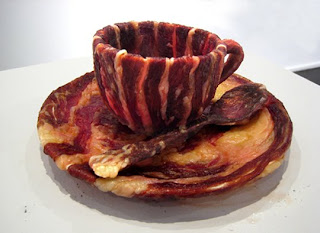Some of us created "macaroni art" in elementary school, painting and gluing dried pasta on a piece of construction paper, or stringing pieces together to make jewelry (which we inevitably gave to our parents, who placated us with an "Oh, how nice!" while trying to figure out how to avoid having to display or wear such a monstrosity).
You might have seen cakes decorated with flowers, as in the photo displayed here. This is a gumpaste rose, on a rolled fondant cake. With a little time and patience, you can make very realistic forms with gumpaste, fondant, and frosting. Even the "pearls" on this piece were edible!
Perhaps you had chocolate bunnies at easter. Seen often around Easter in confectioners, drugstores, and anywhere you find chocolate, these too are a form of food art. While they are commercially produced in mass quantities (not what we'd typically refer to as art), these shapes take the time and effort of several skilled artists to design and to create the mold they are cast from.
On to the more obscure forms of food art.. that's what we're here for!
Spun sugar:
For those who are into high-carb art, this is an amazing medium with limitless possibilities. When sugar is heated to the correct temperature, it takes on a form similar to that of melted glass. You can pull it to make strands, as seen here, or you can blow it into bubble-like shapes, adding additional pieces, pinching and pulling areas, to create any shape you desire!

The forms shown in this photo were molded over small inflated balloons. I heated my sugar, added a little coloring in some batches, and dipped a fork into the melted sugar. From a few inches distance, and while wearing glasses to protect my eyes, I manipulated the pliable sugar strands around the balloon. After cooling, the balloon was punctured near the base and allowed to deflate slowly. The result is a spun-sugar bowl, suitable for serving fruit or a thick mousse in.
Spun sugar is an excellent substitute for the melted sugar glaze on a creme brulee. Just make the sugar shapes in advance, and place them on top of the chilled brulee for a decorative accent. They're edible, attractive, and you won't risk shattering your nice custard dishes under the broiler!
Fruit and Vegetable Sculptures:
Find it hard to get the daily requirement of fresh veggies into your diet, or your children's? Try making it entertaining!
See this site of fruit and veggie sculptures for some inspiration: http://www.photobasement.com/incredible-fruit-and-vegetable-art/
My favorite:

Large fruits can be carved into baskets for holding fruit salad, or root vegetables like turnips and parsnips can be hollowed out, baked, and filled with a savory side like stuffing or soup. Large squash and pumpkins make excellent decorative bowls for their respective soups.
Use your imagination - look at a vegetable carefully, and think of what shape it could become. Most fancy garnishes are just small forms of vegetable or fruit sculpture. Next time you get an interestingly shaped food at a restaurant, ask if you can inquire as to how this was accomplished. Many cooks and chefs are willing to share their techniques if asked.
Bento:
This Japanese form of food art is ideal for making a homemade lunch more enjoyable. It is similar to the fruit and vegetable carving, but includes other foods such as rice, bread, meats, and condiments.
Rice is a very common staple in Japanese bento boxes. Often the rice is molded into interesting shapes, or topped with cute designs made up of condiments and additional ingredients.
Here are some amazingly unique bento creations: http://www.toxel.com/inspiration/2009/05/08/17-amazing-bento-food-art-creations/
My favorite:

You don't need an authentic bento box to make your own bento creation. Tupperware, reused food tubs or baby food jars, and other storage solutions can make a bento box just as tasty, and just as appealing.
Meat Art:
Yeah, I know, it sounds gross, but you'd be surprised. Here's my first view of Meat Art, from www.eatmedaily.com:

Now, fill that cup with some lettuce and tomatoes, and I'm good to go!
View the entire gallery at: http://www.eatmedaily.com/2008/10/meat-after-meat-joy-art-gallery-show/
Now you might ask: "What about food styling? Isn't that food art?"
In a way, yes, they are depicting food in their art. But so much of what you see on TV and in printed advertisements is not actually the food you think it is.

That turkey that looks golden and crisp on the outside, juicy on the inside? It wasn't even cooked! Likely it was barely seared with a torch, spray painted, and manipulated with photo imaging software to look more appetizing. A fully cooked turkey dries out too much to be photographed under hot lights in a studio.

That cool, creamy ice cream? Likely it is actually a potato based mixture, lard, or a vegetable shortening with colorings and additional ingredients to give it the appearance of the flavor it is representing. In many restaurants that show you a plate of example desserts to choose from, they use this same practice.

That cake with the perfect layers? Likely held up by layers of syrofoam or cardboard, to prevent drooping and uneven form. They just pipe additional icing (usually also not very edible) in front of the foam or board supports to hide them.
Many use a cake-comb to fix the appearance of cut pieces of cake, since the knife drags down the top layer when it is cut. My secret: I cut the cake from side to side, rather than top to bottom. It comes out picture-perfect, without photo manipulation or a cake comb.
Hope you've learned something new! If you have any interesting examples of food art, or you want to show off your own, send me a photo or a link.
Happy Wednesday, everyone!



